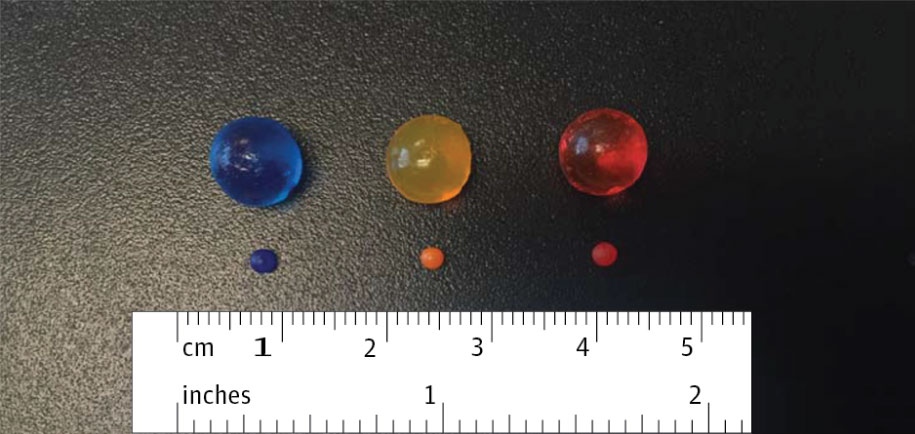'Expanding Bead' Toys May Cause Serious Ear Injuries, Docs Warn

Toys that are made out of tiny beads that expand when they get wet can be a hazard for children, in some cases getting stuck in kids' ears and causing permanent hearing loss, according to a new report.
The report describes the cases of two children who suffered ear injuries after playing with the beads. The beads start small, just 0.04 to 0.08 inches (0.1 to 0.2 centimeters) in diameter, but can grow to 0.4 inches (0.9 cm) when exposed to water.
The beads' small initial size allows them to fit inside the ear or nose of a child, but when kids put the objects in there, they can expand and then get stuck. If the child gets water in his or her ear (for example, during a bath), or if a doctor doesn't realize the beads can expand and tries to remove them using drops or flushing the ear with water, the bead can grow and damage parts of the ear, said Dr. Pamela Mudd, a pediatric ear, nose, and throat (ENT) specialist at Children's National Health System in Washington, D.C., who has treated several patients who had these beads in their ears.
"I think that no children should play with these beads. I think they're very dangerous," Mudd told Live Science. "It's not worth the risk of having permanent hearing loss because the bead expands," she said. [9 Unexpected Ways Kids Can Get Hurt]
In one of Mudd's cases, a 9-year-old girl became deaf in one ear after having an expanded bead in her ear canal for more than 10 weeks. Doctors initially could not figure out what was wrong; the girl had fluid draining from her ear, which can be a symptom of an ear infection, but she didn't respond to antibiotics. She also denied putting anything in her ear.

But further tests revealed significant damage to the ear-canal bone. "We thought she had cancer, because it was so destructive," said Mudd, who is a co-author of the new report.
The bead not only damaged bones of the girl's middle and inner ear, but also damaged nerves that are crucial for hearing, Mudd said. Doctors ended up performing surgery to remove the bead.
Sign up for the Live Science daily newsletter now
Get the world’s most fascinating discoveries delivered straight to your inbox.
In another case, a 6-year-old boy placed several of the expanding beads in his ear, and was taken to the emergency room. Doctors there tried to get the beads out by flushing the ear with water, but it only led to more expansion, moving a bead deeper inside the ear canal, Mudd said.
Because of their experience with the first case, Mudd and colleagues took the boy into surgery and removed the bead. Still, the bead had already started to destroy the boy's middle ear, and had perforated his ear drum. The boy needed two more surgeries to repair the ear drum, and he experienced reversible hearing loss, Mudd said.
Mudd and her colleagues recommend that doctors consider these beads as possible culprits in children who have foreign bodies in their ears. In addition, doctors and emergency room staff should avoid using water or drops in the ear if the child has a bead inside.
"If you see a bead in the ear, don't try and flush it out, because it could be an expanding water bead and that could be dangerous," Mudd said.
Several years ago, pediatricians warned about the dangers of another expanding ball toy, called Water Balz, which can expand to be much larger in water, growing to be several inches in diameter. These toys were recalled after an 8-month-old infant swallowed one of the balls and it blocked her intestine.
But the expanding beads involved in the current cases are still on the market. Although there are several manufacturers of these beads, which are made from a superabsorbent polymer, the main maker of the toys is Orbeez. The beads are intended for children ages 5 and up, and the company does have a warning label on its products about the danger of inserting the beads inside the ear or nose. The beads are marketed as toys themselves, or for use children's in arts-and-craft projects, as well as a "spa" product where the beads are said to soothe the hands and feet.
The company also said on its website that the beads can be a choking hazard for children under age 3. But if swallowed by older children, the beads should pass through the digestive tract without problems, , the company said. Still, Orbeez advised that parents seek medical attention if their children swallow the beads.
Mudd and colleagues have also notified the Consumer Products Safety Commission and the American Academy of Pediatrics about the risks of the beads.
The report is published today (Aug. 4) in the journal JAMA Otolaryngology–Head & Neck Surgery.
Original article on Live Science.

Rachael is a Live Science contributor, and was a former channel editor and senior writer for Live Science between 2010 and 2022. She has a master's degree in journalism from New York University's Science, Health and Environmental Reporting Program. She also holds a B.S. in molecular biology and an M.S. in biology from the University of California, San Diego. Her work has appeared in Scienceline, The Washington Post and Scientific American.









